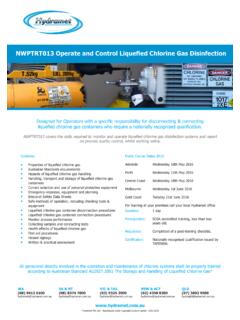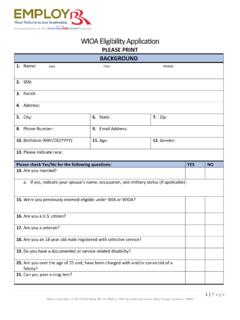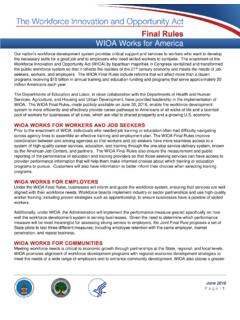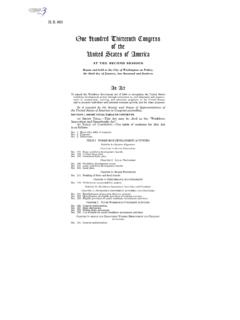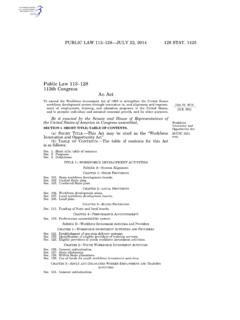Transcription of USING POLYALUMINIUM COAGULANTS IN WATER …
1 64th Annual WATER Industry Engineers and Operators Conference All Seasons International Hotel Bendigo, 5 and 6 September, 2001 Page No 39 USING POLYALUMINIUM COAGULANTS IN WATER TREATMENT Paper Presented by : Peter Gebbie Author: Peter Gebbie Senior Process Engineer Fisher Stewart Pty Ltd 64th Annual WATER Industry Engineers and Operators Conference All Seasons International Hotel - Bendigo 5 and 6 September, 2001 64th Annual WATER Industry Engineers and Operators Conference All Seasons International Hotel Bendigo, 5 and 6 September, 2001 Page No 40 USING POLYALUMINIUM COAGULANTS IN WATER TREATMENT Peter Gebbie, Fisher Stewart Pty Ltd ABSTRACT POLYALUMINIUM COAGULANTS are finding increasing use in potable WATER treatment plants throughout Australia, with POLYALUMINIUM chloride (PACl) in particular now having wide application. This paper reviews the properties and advantages of USING these chemicals with particular reference to experience at Daylesford, the Grampians region, Swan Hill and Tidal River, all in Victoria.
2 KEY WORDS POLYALUMINIUM chloride (PACl), Aluminium chlorohydrate (ACH), COAGULANTS , WATER Treatment INTRODUCTION Alum (aluminium sulphate) is the most commonly used coagulant in Australian WATER treatment plants, low cost being its major attraction. Alum however, has a number of disadvantages: limited coagulation pH range: to , supplemental addition of alkalinity to the raw WATER is often required to achieve the optimum coagulation pH, particularly for soft, coloured surface waters that are common in Australia, residual aluminium levels in the treated WATER can often exceed acceptable limits, and alum floc produced is particularly fragile. This is especially important if a coagulant is required to maximise colour removal in a microfiltration-based WATER treatment process. Alum reacts in WATER to produce aluminium hydroxide and as a by-product sulphuric acid is also formed. The metal hydroxide precipitates out of solution and entraps neutralized charged dirt particles (turbidity), as well as coagulating soluble colour and organics by adsorption.
3 The sulphuric acid produced reacts with alkalinity in the raw WATER to produce carbon dioxide, thus depressing the pH. POLYALUMINIUM COAGULANTS Recently, a number of alternative aluminium-based COAGULANTS have been developed for WATER treatment applications. These compounds have the general formula (Aln(OH)mCl(3n-m))x and have a polymeric structure, totally soluble in WATER . The length of the polymerised chain, molecular weight and number of ionic charges is determined by the degree of polymerisation. On hydrolysis, various mono- and polymeric species are formed, with Al13O4(OH)247+ being a particularly important cation. A less predominant species is Al8(OH)204+. These highly polymerised COAGULANTS include the following: POLYALUMINIUM chloride (PACl, n=2 and m=3), aluminium chlorohydrate (ACH, n=2 and m=5), and POLYALUMINIUM chlorohydrate (PACH): similar to ACH. In practice, there is little difference between the performance of ACH and PACl in WATER treatment applications, even though ACH is more hydrated.
4 ADVANTAGES OF POLYALUMINIUM COAGULANTS 64th Annual WATER Industry Engineers and Operators Conference All Seasons International Hotel Bendigo, 5 and 6 September, 2001 Page No 41An important property of POLYALUMINIUM COAGULANTS is their basicity. This is the ratio of hydroxyl to aluminium ions in the hydrated complex and in general the higher the basicity, the lower will be the consumption of alkalinity in the treatment process and hence impact on pH. Various suppliers of ACH and PACl in Australia express the basicity of their product as a percentage Omega MEGAPAC-23 ( w/w aluminium chlorohydrate) has a basicity of 82% (Omega Chemicals, 2000). The POLYALUMINIUM COAGULANTS in general consume considerably less alkalinity than alum. They are effective over a broader pH range compared to alum and experience shows that PACl works satisfactorily over a pH range of to Another important advantage of USING POLYALUMINIUM COAGULANTS in WATER treatment processes is the reduced concentration of sulphate added to the treated WATER .
5 This directly affects SO4 levels in domestic wastewater. A raw WATER with a sulphate level of 3 to 5 mg/L will typically have a SO4 concentration of 15 to 25 mg/L following treatment with alum. The amount of soluble sulphate present in domestic wastewater is now also significantly increased and this can result in elevated hydrogen sulphide production in the sewerage system, leading to odour and corrosion problems. Table 1: Typical aluminium-based COAGULANTS used in WATER treatment STRENGTH, % w/w TYPICAL PRICE EX WORKS MEL, $/kg CHEMICAL SYMBOL SUPPLIER NAME COMPOSITION FORMULA WT. Al2O3 Al AS IS SG at 20oC OTHER AS IS 100% Al Aluminium Chlorohydrate ACH OMEGA MEGAPAC 23 Al2(OH) Basicity 82% Chloride pH Aluminium Chlorohydrate ACH ALUMINATES PAC 23 (APAC 333) Al2(OH) Basicity 83-85%, Cl , pH POLYALUMINIUM Chloride PACl OMEGA MEGAPAC 10 Al2(OH) Basicity 55% Chloride pH POLYALUMINIUM Chloride PACl DELTREX AC100S Al2(OH) Sulphate pH POLYALUMINIUM Chloride PACl DELTREX SAB18 Al2(OH) Sulphate nil pH Aluminium Sulphate ALUM ALUMINATES, OMEGA LIQUID ALUM Al2(SO4) pH Sodium Aluminate - ALUMINATES - NaAlO2 ( )
6 12% NaOH Na2O pH 14 64th Annual WATER Industry Engineers and Operators Conference All Seasons International Hotel Bendigo, 5 and 6 September, 2001 Page No 42At one WATER treatment plant in the Otway region of Victoria, POLYALUMINIUM chloride replaced alum and in so doing SO4 levels in the treated WATER were reduced from 27 to 4 - 5 mg/L. Previously, alum was dosed at 45 to 55 mg/L at this plant. The change to PACl had a major impact on SO4 levels in the sewage, with reduced odour problems evident at several pump stations in the sewerage system. Table 1 summarises principal characteristics of commercially available POLYALUMINIUM COAGULANTS . Details for alum and sodium aluminate are also included for comparison. Other advantages of POLYALUMINIUM COAGULANTS include the following: low levels of residual aluminium in the treated WATER can be achieved, typically mg/L, PACl and ACH work extremely well at low raw WATER temperatures.
7 Flocs formed from alum at low temperatures settle very slowly, whereas flocs formed from POLYALUMINIUM COAGULANTS tend to settle equally well at low and at normal WATER temperatures, less sludge is produced compared to alum at an equivalent dose, lower doses are required to give equivalent results to alum. For example, a dose of 12 mg/L PACl (as 100%) was required for treatment of a coloured, low turbidity WATER (Otway region, Victoria) compared to similar performance obtained when USING an alum dose of 55 mg/L, and the increase in chloride in the treated WATER is much lower than the sulphate increase from alum, resulting in lower overall increases in the TDS of the treated WATER . From Table 1, it will be noted that POLYALUMINIUM COAGULANTS are typically twice the price of liquid alum on per kilogram aluminium basis. However, lower doses of the coagulant and lower pre- and post-treatment alkali doses can still make its use economical.
8 POLYALUMINIUM chloride solution (10% Al2O3) is stable for 4 to 5 months when stored at less than 50oC and is so ideal for bulk storage and dosing installations. One possible disadvantage in USING ACH/PACl relates to the removal of dissolved organic carbon (DOC) from WATER . It is well documented that effective DOC removal is possible with alum, particularly when coagulating at lower pH values USING so-called enhanced coagulation . Alum appears to be a superior coagulant as far as removal of humic and fulvic colour constituents are concerned. A higher coagulation pH is adopted with POLYALUMINIUM COAGULANTS and it possible that removal of THM percussors may not be as complete as with alum. The following examples illustrate that this depends on the particular raw WATER in question and in many cases may not be an issue. DAYLESFORD The Daylesford WATER Filtration Plant is a new 8 ML/d in-filter/dissolved air flotation plant constructed by Vivendi WATER /US Filter, with process and detailed design, engineering and procurement provided by Fisher Stewart.
9 The plant treats highly coloured raw WATER from either the Wombat or Bullarto Reservoirs. Raw WATER characteristics for the supply from Wombat Reservoir are detailed in Table 2. The WATER is also very corrosive with a pH which can be as low as and a calcium carbonate precipitation potential (CCPP) value of mg/L CaCO3 (at 20oC). Typically this WATER supply has a true colour of 30 Pt/Co units and a turbidity of NTU, although on occasions the colour can approach 100 Pt/Co units. The temperature of the raw WATER can be as low as 5oC in winter months. For raw WATER at 20oC with a true colour of 60 Pt/Co units, turbidity NTU and pH , WaterQual (a WATER treatment and quality assessment model developed by the author at Fisher Stewart) was used to compare the predicted performance of alum versus PACl. A chlorine dose of 64th Annual WATER Industry Engineers and Operators Conference All Seasons International Hotel Bendigo, 5 and 6 September, 2001 Page No mg/L for disinfection and a target treated WATER pH of were adopted for each case.
10 For an alum dose of 45 mg/L and a coagulation pH of , pre- and post-treatment doses of caustic soda of and mg/L were required (total mg/L). Table 2: Raw WATER Analysis, Wombat Reservoir at Daylesford ION mg/L CaCO3 mg/L EC S/ cm ION mg/L CaCO3 mg/L CALCIUM 71 ALKALINITY MAGNESIUM pH CHLORIDE SODIUM SULPHATE POTASSIUM These projections compare well with the results of jar-test investigations carried out to determine the treatability of raw WATER supplies at Daylesford USING alum (GHD 1996). An equivalent PACl dose of 12 mg/L as 100% was adopted and used in the WaterQual model. Addition of caustic soda at mg/L was necessary to achieve a coagulation pH of A post-treatment alkali dose of mg/L was required in this instance (total dose mg/L). Characteristics of the treated WATER for each coagulant option determined from WaterQual are given in Table 3.



